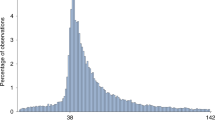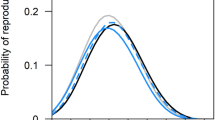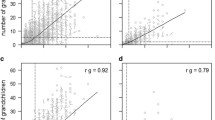Abstract
Based on historical data pertaining to the Krummhörn population (eighteenth and nineteenth centuries, Germany), we compared reproductive histories of mothers according to whether the maternal grandmother (MGM) or the paternal grandmother (PGM) or neither of them was resident in the parents’ parish at the time of the mother’s first birth. In contrast to effects of PGMs, we discovered conditional differences in the MGM’s effects between landless people and wealthier, commercial farmers. Our data indicate that the presence of the MGM only lowers the woman’s age at marriage (AAM) and her age at the birth of her first child (AFB) in the case of landless families. However, among commercial farmers, who can generally be characterized by a lower AAM and AFB, we found opposite tendencies for the MGM’s effect leading to a relatively small delay in AAM and AFB. Moreover, we also analyzed differences in the completed fertility (i.e., children ever born: CEB). Results indicate that landless families in general do have fewer CEB compared with commercial farmers except for those families in which the MGM has been present. Emphasizing that the adaptiveness of investment decisions should depend on the interaction of genetic, lineage-specific (intrinsic) and ecologically imposed (extrinsic) constraints, we conclude that kin strategies consequently address different fitness components under different conditions.




Similar content being viewed by others
References
Allal, N., Sear, R., Prentice, A. M., & Mace, R. (2004). An evolutionary model of stature, age at first birth and reproductive success in Gambian women. Proceedings of the Royal Society B, 271, 465–470.
Apostolou, M. (2010). Sexual selection under parental choice in agropastoral societies. Evolution and Human Behavior, 31, 39–47.
Bailey, D., & Alimadhi, F. (2007). Poisson.mixed: Mixed effects poisson model. In K. Imai, G. King, & O. Lau (Eds) Zelig: Everyone’s Statistical Software, URL http://gking.harvard.edu/zelig.
Balakrishnan, T. R., Vaninadha Rao, K., Krotki, K. J., & Lapierre-Adamcyk, E. (1988). Age at first birth and lifetime fertility. Journal of Biosocial Science, 20, 167–174.
Beekman, M., Komdeur, J., & Ratnieks, F. L. W. (2003). Reproductive conflicts in social animals: who has power? Trends in Ecology and Evolution, 18, 277–282.
Beise, J., & Voland, E. (2008). Intrafamilial resource competition and mate competition shaped social-group-specific natal dispersal in the 18th and 19th century Krummhörn population. American Journal of Human Biology, 20, 325–336.
Borgerhoff Mulder, M. (2009). Tradeoffs and sexual conflict over women’s fertility preferences in Mpimbwe. American Journal of Human Biology, 21, 476–487.
Clarke, A. L., & Low, B. S. (2001). Testing evolutionary hypotheses with demographic data. Population and Development Review, 27, 633–660.
Coall, D. A., & Hertwig, R. (2010). Grandparental investment: past, present, and future. Behavioral and Brain Sciences, 33, 1–59.
Devos, I., & Kennedy, L. (Eds.). (1999). Marriage and rural economy: Western Europe since 1400. Turnhout: Brepols.
Euler, H. A., & Michalski, R. L. (2007). Grandparental and extended kin relationships. In C. A. Salmon & T. K. Shackelford (Eds.), Family relations—An evolutionary perspective (pp. 230–256). Oxford: Oxford University Press.
Flinn, M. V. (1988). Parent-offspring interactions in a Caribbean village: daughter guarding. In L. Betzig, M. Borgerhoff Mulder, & P. W. Turke (Eds.), Human reproductive behaviour (pp. 189–200). Cambridge: Cambridge University Press.
Gehrmann, R. (2003). Heiratsverhalten als historisches Problem. Historical Social Research, 28, 8–28.
Houston, A. I., Székely, T., & McNamara, J. M. (2005). Conflict between parents over care. Trends in Ecology and Evolution, 20, 33–38.
Hrdy, S. B. (2009). Mothers and others: The evolutionary origins of mutual understanding. Cambridge: Harvard University Press.
Johow, J., Fox, M., Knapp, L., & Voland, E. (2011). The presence of a paternal grandmother lengthens interbirth interval following the birth of a granddaughter in Krummhörn (18th and 19th centuries). Evolution and Human Behavior, 32, 315–325. doi:10.1016/j.evolhumbehav.2010.11.004.
Kadir, M. M., Fikree, F. F., Khan, A., & Sajan, F. (2003). Do mothers-in-law matter? Family dynamics and fertility decision-making in urban squatter settlements of Karachi, Pakistan. Journal of Biosocial Science, 35, 545–558.
Kaplan, H., Lancaster, J. B., Tucker, T. W., & Anderson, K. G. (2002). Evolutionary approach to below replacement fertility. American Journal of Human Biology, 14, 233–256.
Klindworth, E., & Voland, E. (1995). How did the Krummhörn elite males achieve above-average reproductive success? Human Nature, 6, 221–240.
Leonetti, D. L., Nath, D. C., & Hemam, N. S. (2007). In-law conflict: Women’s reproductive lives and the roles of their mothers and husbands among the matrilineal Khasi. Current Anthropology, 48, 861–890.
Lorenzen-Schmidt, K. J. (2003). Bäuerliches Heiratsverhalten und Stellenübertragung in den holsteinischen Elbmarschen (1650-1950). Historical Social Research, 28, 76–91.
Margadant, T. W. (1998). Marriage contracts and stem-family households in the Lot-et-Garonne, 1812–1872. In G. Brunet, A. Fauve-Chamoux, & M. Oris (Eds) Le choix du conjoint (pp. 283–294). Lyon.
Martinussen, T., & Scheike, T. H. (2006). Dynamic regression models for survival data. New York: Springer.
Ohling, G. D. (1963). Kulturgeschichte der Krummhörn. In J. Ohling (Ed.), Die Acht und ihre sieben Siele. Kulturelle, wasser- und landwirtschaftliche Entwicklung einer ostfriesischen Küstenlandschaft (pp. 18–288). 1. Entwässerungsverband Emden: Pewsum.
Penn, D. J., & Smith, K. R. (2007). Differential fitness costs of reproduction between the sexes. Proceedings of the National Academy of Sciences USA, 104, 553–558.
Pollet, T. V., Nelissen, M., & Nettle, D. (2009). Lineage based differences in grandparental investment: Evidence from a large British cohort study. Journal of Biosocial Science, 41, 355–379.
R Development Core Team. (2010). R: A language and environment for statistical computing. Vienna: R Foundation for Statistical Computing.
Reiches, M. W., Ellison, P. T., Lipson, S. F., Sharrock, K. C., Gardiner, E., & Duncan, L. G. (2009). Pooled energy budget and human life history. American Journal of Human Biology, 21, 421–429.
Robson, S. L., Hawkes, K., & van Schaik, C. P. (2006). The derived features of human life history. In K. Hawkes & R. L. Paine (Eds.), The evolution of human life history (pp. 17–44). Santa Fe: School of American Research Press.
Røskaft, E., Wara, A., & Viken, A. (1992). Reproductive success in relation to resource-access and parental age in a small Norwegian farming parish during the period 1700–1900. Ethology and Sociobiology, 113, 443–461.
Rotkirch, A., & Janhunen, K. (2009). Maternal guilt. Evolutionary Psychology, 8, 90–106.
Schlumbohm, J. (1991). Social differences in age at marriage: examples during the XVIIIth and XIXth centuries. In E. Helin (Ed.), Historiens et populations (pp. 593–607). Louvain-la-Neuve: Academia.
Sear, R. (2008). Kin and child survival in rural Malawi. Human Nature, 19, 277–293.
Sear, R., & Mace, R. (2008). Who keeps children alive? A review of the effects of kin on child survival. Evolution and Human Behavior, 29, 1–18.
Sear, R., & Mace, R. (2009). Family matters: kin, demography and child health in a rural Gambian population. In G. R. Bentley & R. Mace (Eds.), Alloparenting in human societies (pp. 50–76). Cambridge: Cambridge University Press.
Sear, R., Mace, R., & McGregor, I. A. (2003). The effects of kin on female fertility in rural Gambia. Evolution and Human Behavior, 24, 25–42.
Skinner, G. W. (2004). Grandparental effects on reproductive strategizing: Nobi villagers in early modern Japan. Demographic Research, 11, 111–147.
Skjærvø, G. R., Bongard, T., Vikenc, Å., Stokke, B. G. D., & Røskaft, E. (2011). Wealth, status, and fitness: a historical study of Norwegians in variable environments. Evolution and Human Behavior, 32, 305–315. doi:10.1016/j.evolhumbehav.2010.11.006.
Therneau, T. (2009). Survival: Survival analysis, including penalised likelihood. R package version 2.35-8. http://CRAN.R-project.org/package=survival.
Toomet, O., & Henningsen, A. (2008). Sample selection models in R: Package sampleSelection. Journal of Statistical Software 27(7). http://www.jstatsoft.org/v27/i07/.
Udry, J. R., & Cliquet, R. L. (1982). A cross-cultural examination of the relationship between ages at menarche, marriage, and first birth. Demography, 19, 53–63.
Voland, E. (1990). Differential reproductive success within the Krummhörn population (Germany, 18th and 19th Centuries). Behavioral Ecology and Sociobiology, 26, 65–72.
Voland, E. (1998). Evolutionary ecology of human reproduction. Annual Review of Anthropology, 27, 347–374.
Voland, E. (2000). Contributions of family reconstitution studies to evolutionary reproductive ecology. Evolutionary Anthropology, 9, 134–146.
Voland, E., & Beise, J. (2002). Opposite effects of maternal and paternal grandmothers on infant survival in historical Krummhörn. Behavioral Ecology and Sociobiology, 52, 435–443.
Voland, E., & Beise, J. (2005). “The husband’s mother is the devil in house”: Data on the impact of the mother-in-law on stillbirth mortality in historical Krummhörn (1750–1874) and some thoughts on the evolution of postgenerative female life. In E. Voland, A. Chasiotis, & W. Schiefenhövel (Eds.), Grandmotherhood: The evolutionary significance of the second half of female life (pp. 239–255). New Brunswick: Rutgers University Press.
Voland, E., & Dunbar, R. I. M. (1997). The impact of social status and migration on female age at marriage in an historical population in north-west Germany. Journal of Biosocial Science, 29, 355–360.
Voland, E., & Engel, C. (1990). Female choice in humans: a conditional mate selection strategy of the Krummhörn women (Germany, 1720–1874). Ethology, 84, 144–154.
Voland, E., Chasiotis, A., & Schiefenhövel, W. (Eds.). (2005). Grandmotherhood: The evolutionary significance of the second half of female life. New Brunswick: Rutgers University Press.
Acknowledgments
We would like to thank Isabelle Cobres for inspiring discussion. In addition, we are thankful to two anonymous reviewers for providing valuable help during earlier stages of the manuscript. Financial support came from Deutsche Forschungsgemeinschaft (DFG) and from a personal grant to JJ from the University of Giessen.
Author information
Authors and Affiliations
Corresponding author
Electronic Supplementary Materials
Below is the link to the electronic supplementary material.
ESM 1
(PDF 204 kb)
Rights and permissions
About this article
Cite this article
Johow, J., Voland, E. Conditional Grandmother Effects on Age at Marriage, Age at First Birth, and Completed Fertility of Daughters and Daughters-in-law in Historical Krummhörn. Hum Nat 23, 341–359 (2012). https://doi.org/10.1007/s12110-012-9147-7
Published:
Issue Date:
DOI: https://doi.org/10.1007/s12110-012-9147-7




